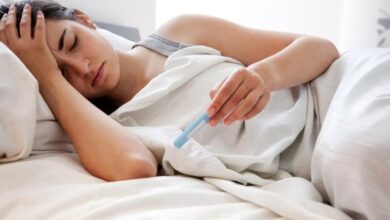How to protect yourself. / Heed the warning signs: How to spot heatstroke
When it’s hot, circulatory problems can quickly develop – sometimes with serious consequences. That’s why you should take countermeasures quickly at the first sign of sunstroke or heat stroke.
Because initially the body can compensate for high temperatures by sweating. However, if it is exposed to excessive heat for too long, the natural cooling system gets out of step.
Sunstroke: These people are particularly at risk
Heat, high humidity and sun cause problems for the body. You should therefore wear a hat to protect yourself from sunstroke. This applies in particular to people with little hair such as babies, children and people with thinning hair or bald heads.
But that doesn’t mean that thick hair protects against sunstroke and heat stroke: sunstroke occurs when the head is exposed to direct sunlight. The radiation irritates the meninges under the skull. Overheating can happen to anyone, especially people with poor circulation.
If you are in the blazing sun for a while without a hat, the meninges can become irritated – in severe cases it can even lead to brain swelling.
Sunstroke: Symptoms at a glance
Typical symptoms of sunstroke are:
neck and headaches
The head and neck are red
dizziness
circulatory problems
exhaustion
restlessness
nausea to the point of vomiting
If sunstroke is suspected, a clinical thermometer is unfortunately useless: the body temperature often remains unchanged. However, high fever can occur after a long period of time.
Incidentally, this applies to all symptoms of sunstroke: If you feel good while sunbathing, this is not an indication that the body can really tolerate the high temperatures.
The duration of a sunstroke varies from person to person. For some, the symptoms subside within a few hours, while others suffer from the symptoms for up to two days. Adults tend to recover faster than children and seniors.
First aid for heatstroke
The following measures can help with sunstroke:
Get out of the sun and into a cool place immediately.
Gently cool the red and hot head with wet towels.
Position your torso elevated.
Drink enough.
In an emergency, dial the emergency number 112.
Heat Stroke: Recognize signs immediately
Heatstroke is to be distinguished from sunstroke. It occurs in humid conditions and extreme heat and occurs when the body absorbs more heat than it can emit due to high temperatures. The result can be the following symptoms:
The body temperature rises suddenly, sometimes in just 15 minutes up to 41 degrees.
The skin is hot, red and very dry.
The pulse beat is accelerated.
Affected people are restless, sleepy, tired, exhausted or confused.
A strong feeling of thirst and headache may occur.
Cramps and vomiting or dizziness may occur.
Confusion or hallucinations may occur.
It can even lead to unconsciousness.
First aid for heat stroke
Heatstroke is life-threatening – and therefore always a case for the emergency doctor by dialing 112. Until help arrives, you should take the following measures:
Get the affected person out of the sun immediately and place them in the shade.
Elevate his torso.
Offer something to drink: water, juice spritzers or fruit teas.
Cool the body carefully with wet towels – especially in the head and neck area. Caution: Ice must not be on the skin.
If the person is drowsy, put their feet up; if she has lost consciousness, place her in the recovery position.
Caution: For laypeople, sunstroke and heat stroke are often difficult to distinguish. If in doubt, it is better to dial 112 quickly.
Avoid sunstroke and heatstroke
At midday, when the sun is at its highest, the heat hits the head particularly directly. You should therefore avoid the midday sun to avoid sunstroke or heat stroke. It is also best to protect your head and neck with light-colored sun hats – this is especially true for children and babies. A parasol also provides shade.
Also, avoid physical exertion. Because people who do sports despite the heat are at high risk. Anyone who does not want to do without their daily exercise is better off doing sport in the slightly cooler morning or evening hours.
But raging children also need special protection. Unventilated rooms in which heat accumulates can also promote heat stroke.
In general, it is important to drink enough and, above all, evenly. It’s best not to get thirsty in the first place, as that is a sign of dehydration. At least 1.5 liters a day are recommended, and more in hot weather – ideally water, juice spritzers or unsweetened tea.
Heat wave in France: Red warning level for the Atlantic coast

 Bornavirus in Bavaria: Experts sound the alarm
Bornavirus in Bavaria: Experts sound the alarm PCOS self-test: How do you know if you have PCOS?
PCOS self-test: How do you know if you have PCOS? New Corona variant XEC on the rise: more flu-like and more contagious
New Corona variant XEC on the rise: more flu-like and more contagious Bloated stomach like you’re pregnant: Causes and help
Bloated stomach like you’re pregnant: Causes and help